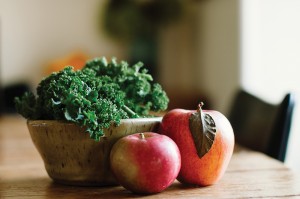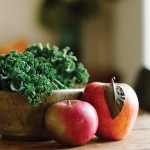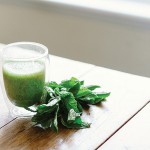What you eat has healing power
story by Emily Worts, photography by Jessica Crandlemire

When my family starts to feel a little less than awesome, it is not surprising that I turn to food first. In my clan food has always been medicinal. When I was home sick from school with a sore throat or a cold my mom made me homemade cheese and noodles – not what you would expect to be fed when feeling under the weather, but for whatever reason it always made me feel just about right. Nothing healed me faster than being cuddled up under a blanket on the couch with a bowl of rich, creamy noodles.
For a friend it is canned pears; for my husband it is always boiled eggs and toast. We all have our comfort foods that heal and soothe us. I am not a doctor, a naturopath or even a reader of health magazines, but I have great confidence in food-based home remedies. For me that means recipes and reasonings that have been passed on to me from my mother, from her mother and so on, and tweaked here and there throughout the ages.
In our home if you’re feeling a little feverish, it’s time for chicken stock augmented with chunks of ginger, whole garlic cloves, fresh squeezed lime juice and an ample dose of hot chillies. When my boys are suffering from a relentless cough they willingly open their mouths wide for a tablespoon of honey. When I’m achy and feeling awful due to congestion or a cold, I always start with warm water, lemon, honey and ginger. And, whatever the time of year, if we can’t sleep we all know a cup of warm milk with honey will do the trick.
I’m not entirely sure why these home remedies work, but they do. My theories aren’t based on science but make sense to me. We sweat out our fevers with the help of chillies and garlic; we coat our irritated throats with honey; we clear our systems with the stringent power of ginger; and, well, warm milk just makes you feel sleepy. Part of the power of a home remedy comes from the test of time and the conviction with which we use it. Panacea? Placebo? Perhaps, but the result is the same.
With the falling of the leaves and the first surprise dusting of snow, we begin looking for immune boosters in all their forms: over-the-counter supplements, increased exercise, and extra citrus in our diet. For me, keeping my family healthy, any time of the year, always starts with what we put in our bellies. I’m not a huge fan of exercise for the sake of exercise (I enjoy the social aspects a little more) and I don’t subscribe to chemical reincarnations of what an orange can give me. I am a firm believer that everything our bodies need to stay healthy is available to us in its purest form, on the produce shelves of the supermarket or from our many farm markets and 100-mile stores.
I am not claiming that food heals all. Of course, serious diseases like cancer require medical intervention, but doctors often recommend dietary changes to help (and in some cases prevent) illnesses such as diabetes, celiac disease and heart disease. Healthy eating is simply the best, most natural way to get – and stay – healthy.
There was a certain cookbook floating around this past summer, its deliciously nutritious-looking cover turning up on every kitchen counter I came across: The Oh She Glows Cookbook by Angela Liddon. My 16-year-old niece was pining for it and my yoga instructor had recently bought it on her yoga instructor’s recommendation. It seemed I had to have it.
This cookbook has surprised me. Unlike many others, which have been purchased for their photographs, for a single recipe or because they take me away at a time when I’m not travelling as much as I would like, this one hasn’t been shelved after a week.
We recently had guests who knew this cookbook and commented that they hate when people leave cookbooks out, advertising a certain lifestyle that they may or may not adhere to. I defended myself and said “but I actually use this one” and cooked solely from it for the weekend ahead. The amazing thing for me, as an unabashed carnivore, is that everything in this book is vegan. I support friends and family who decide to go down their own culinary paths, be it for health, political or environmental reasons, but I have always chosen a path with no particular destination – full exploration with a variety of meandering routes that allow me to try almost anything in the name of adventure. So I bought a vegan cookbook, certain that it would be relegated to that part of my collection (along with the raw food cookbook and the bean cookbook) that doesn’t get much action. I was wrong.
This cookbook stays on my kitchen island to aid me in the making of my morning smoothie (I am drinking a mojito-inspired smoothie as I write this, and although not quite as delicious as the alcoholic version, it is a much healthier way to start my day). It helps my family in our goal to eat less meat, and after 20 years of cooking for a living it has given me much inspiration. It has also reinforced the powerful fact that food heals every day, not just when we’re feeling sick.
I am the only person I know (but I have a hunch I picked this up from my mother) who reads the foreword of every cookbook I purchase. I like to know a little bit about the person who is going to help feed me and my family. Liddon suffered from an unhealthy relationship with food that led to a cycle of poor eating habits before she changed her perspective and found the healing qualities of food.
The fact that food heals isn’t a secret, nor is it a new concept, yet I find it surprising how often we forget this. To me it is basic. What you put in is what you get out. If you put highly processed, low-fat, chemically enhanced ‘food’ into your belly you likely won’t feel nearly as great as if you put in whole, fresh, real food. It might not be an instant pick-me-up (like a can of Red Bull), but bit by bit you will start to feel better.
Using this cookbook has made me feel better. I am eating less meat than I ever have, I am eating more legumes and beans than I thought possible, and with cold and flu season upon us I am feeling better than ever.
I can’t list all the benefits of a kitchen pharmacy in this short space, but it is amazing how much ‘medicine’ you will find there. A friend recently lent me an Ayurveda book and I immediately flipped to the glossary of foods that can heal. I didn’t know a pinch of baking soda mixed with the juice from half a lemon and some warm water is great for indigestion and the relief of gas; or that half a teaspoon of ginger powder mixed with a little water, heated and rubbed on my forehead, can bring instant relief from a headache; or that nutmeg can help with insomnia.
It is not within my realm to advise, but merely to suggest that overall health begins on the produce shelf of the grocery store, at your local farmer’s market or 100-mile shop, in your own veggie patch and on your spice rack. It is here we should look first, not our medicine cabinet, when we feel an ache coming on. A change of perspective is sometimes all we need to feel better in so many ways. ❧
Recipe
Inspired by The Oh She Glows Cookbook: Over 100 Vegan Recipes to Glow from the Inside Out, by Angela Liddon
Mojito Smoothie
1 cup coconut water
1 cup torn kale leaves (any hearty green will do)
1 large apple
1 banana (can substitute with half an avocado)
Mint leaves to taste (about 5)
Juice of half a lime
5 ice cubes
In a high-speed blender, whiz all the ingredients until smooth.












